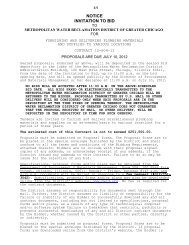Report - Metropolitan Water Reclamation District of Greater Chicago
Report - Metropolitan Water Reclamation District of Greater Chicago
Report - Metropolitan Water Reclamation District of Greater Chicago
Create successful ePaper yourself
Turn your PDF publications into a flip-book with our unique Google optimized e-Paper software.
including calibration and validation as needed in 2011. When complete, the dynamic model will<br />
allow for the evaluation <strong>of</strong> plant capacity and plant operations and will assist in evaluating plant<br />
expansion options. An M&R report detailing the dynamic modeling <strong>of</strong> the North Side WRP will<br />
be prepared in 2011.<br />
Literature Review on Nitrification Rate. A literature review was completed for<br />
nitrification rate testing. The literature review will aid in the development <strong>of</strong> a standard<br />
operating procedure (SOP) for a quick determination <strong>of</strong> nitrification rates. The SOP will be<br />
utilized to regularly track nitrification rates at the <strong>District</strong>'s plants over time and troubleshoot<br />
plant upsets.<br />
Ferrate Disinfection Evaluation. The WTPR Section evaluated a process for wastewater<br />
disinfection using ferrate. Bench scale tests were conducted in the WTPR laboratory to evaluate<br />
the process <strong>of</strong> ferrate synthesis and application <strong>of</strong> ferrate for disinfection. The test results<br />
indicate that highly unstable ferrate could be synthesized on site and used for effective<br />
wastewater disinfection. However, the tests also showed that due to the amount <strong>of</strong> chemicals<br />
required for ferrate synthesis and effective disinfection, the process is not cost effective<br />
compared with chlorination and dechlorination and ultraviolet light.<br />
Potential Energy Savings at Hanover Park <strong>Water</strong> <strong>Reclamation</strong> Plant Using Anoxic Zone<br />
and at Egan <strong>Water</strong> <strong>Reclamation</strong> Plant Using Chemical Enhanced Primary Settling. The WTPR<br />
Section has initiated two full-scale testing projects targeting energy savings at the <strong>District</strong> plants<br />
in 2009. One project is to introduce an anoxic zone in an aeration tank at the Hanover Park WRP<br />
to reduce aeration, and the other is to use polymer and/or FeCh to enhance settling in the primary<br />
settling tanks at the Egan WRP. During 2010, the WTPR Section worked with the Engineering<br />
Department on developing design parameters through site visits and laboratory bench-scale tests,<br />
and aided the Engineering Department on preparing a scope <strong>of</strong> work. and contract specifications<br />
under Engineering Department project 06-494-3P. Full-scale testing is expected to commence in<br />
2012.<br />
Responding to Other Requests for Technical Support. In 2010, the WTPR Section<br />
provided the following technical support to other requests.<br />
Support for Studies Relating to Illinois Pollution Control Board Rulemaking on Dissolved<br />
Oxygen Standards for the <strong>Chicago</strong> Area <strong>Water</strong>way System. In support <strong>of</strong> the studies relating to<br />
the IPCB rulemaking on DO standards for the CAWS, the WTPR Section provided data analysis<br />
on the relation <strong>of</strong> DO concentrations in the waterway to urban wet-weather run<strong>of</strong>f and CSO<br />
events. In addition, the WTPR Section participated in an Engineering Department project on<br />
integrated strategy to meet DO water quality standards for the CAWS through attending<br />
workshop discussion and reviewing documents for the project.<br />
24
















